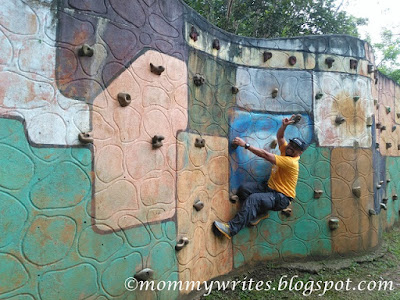Last October 11, 2015, the city government of Quezon and its constituents culminated its week-long celebration of its 75th Anniversary. The celebration was held at the Quezon Memorial Circle with a parade of various floats from different districts of Quezon City.
These mobile floats were made by creative talents from each district. The mobile floats paraded through the key streets of Kalayaan and V. Luna then, Maginahawa Street then went back again to the Quezon Memorial Circle. As they enter near the stage, each one is presented to the audience by some celebrities who are also Quezon City residents.
The celebration was hosted by two very energetic emcees with Mr. Daniel Matsunaga who presented the first mobile float to arrive. As much as he struggles with his Tagalog, he did pretty well in presenting the float.
The first one to arrived is the float from Mabuhay Rotonda. Formerly know as Welcome Rotonda. for the information of everybody, Mabuhay Rotonda marks as the boundary of City of Manila and Quezon City. It has been has been a significant landmark because of the hundreds of demonstration and rallies that were held in that place during the Marcos regime.
The next one to arrive was the float of the Quezon Memorial Tower. This monument holds the remains of the Philippines' great leader, Common Wealth President Manuel L. Quezon and his wife Aurora Quezon. MLQ envisioned it to be as the Government capital that holds the main offices of government agencies.
This float is the replica of Bantayog ng mga Bayani. The monument represents the fallen heroes who fought injustices by the Marcos Regime. It is made of brass hand crafted by our very own artist/sculpture Ed Castrillio. Mr. Castrillio is a well known for his public art and nationalistic artworks. The monument is mounted along Quezon Avenue, near Philippine Heart Center.
Another Ed Castrillio's masterpiece is the People Power Monument located near Camp Aguinaldo along EDSA. This monument represents the historical event happened in our country where the people fought the Marcos dictatorship on the streets of EDSA in a bloodless revolution. The revolt was triggered by the unjustly murder of Sen. Ninoy Aquino in 1983 that ignited a people power revolution in 1986.
Another iconic figure that can be found in Quezon City is the Oblation of the University of the Philippines, Diliman. The original statue of this replica can be found inside the main library of the university. This work of art is a masterpiece of a renowned Filipino artist Guelliermo Tolentino. Tolentino was commissioned by then UP president Rafael Palma. The statue is made of concrete and it depicts a man facing upwards with stretched open arms, symbolizing the selfless offering of oneself to his country.
This float is a replica of the Tandang Sora shrine located at Banlat Road, Tandang Sora, Quezon City. The original statue was sculpted by Toym Imao in honor of the life and service of Melchora Aquino, also known as Tandang Sora. Tandang Sora is known for her selfless service in taking care of many wounded katipuneros during the Spanish colonial revolution.
One of Quezon City's iconic food destination is the Laloma lechon. Lechon is the traditional roasted pig that is quite famous in every Filipino festivity. The District of Laloma is located north-west of Quezon city and this district is known to be visited by people from all over to experience their famous lechon.
This is the replica of the iconic artwork in front of the Philippines Heart Center. It is a sculpture of a coronary artery of the heart - PUSO. The original art work is currently mounted at the Philippine Heart Center. It is created by an artist who happens to be a renowned cardiologist as well and he is Dr. William T. Chua.
This float is a creative representation of Payatas. Payatas used to hold all the garbage of Metro Manila. The land is now a thriving low-cost housing development for the employees of Quezon City government known as Bistek-Vill. This housing development is an initiative of the city government of Quezon City for retiring city government employees who do not have a decent place to live. The development is in partnership with Habitat for Humanity.
The last float is the replica of the Quezon City Hall. The 14 story building was constructed by the initiative of then President Ramon Magsaysay and he commissioned Mayor Norberto Amoranto to build the new City Hall in a 12 hectare of land at the elliptical road. The new cornerstone for the new City Hall was laid in 1962 but the construction began in 1964.
After the Grand Parade of Lights, the celebration continued with the performances of some of the most sought after bands which includes some rising talented bands, RockSteady, Parokya Ni Edgar and many more. The celebration concludes with a colorful display of FireWorks that filled the Quezon City sky.


















































